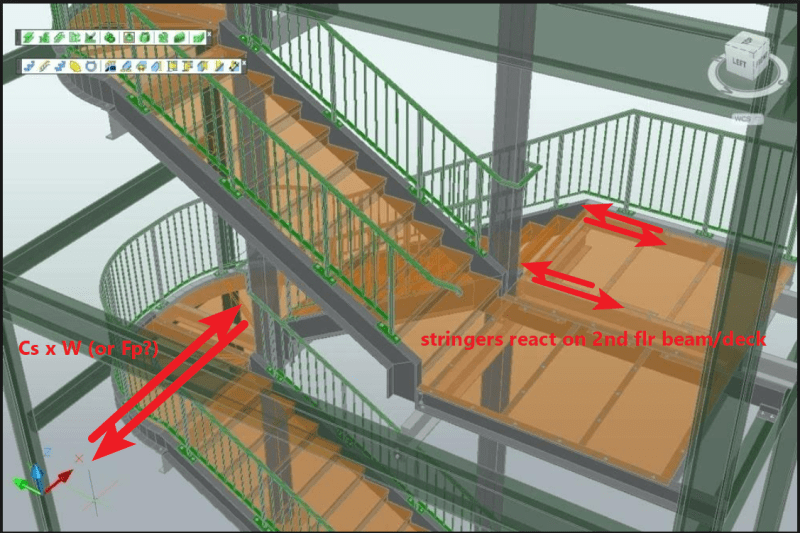Gnique
Structural
- May 9, 2016
- 6
thread507-411736
I went through the 2016 thread looking for guidance and still felt the need to consult with the inmates here. If we take a stair / landing assembly where the landing is supported by four supports free to translate (within say 3" each way) in the X-Y plane and the lower run of stairs free to translate in the X-Y supported by a concrete floor slab with the upper flight connected at the stringer ends to the building structure. Further suppose that the assembly is NOT on the ground floor. It is reasonable to assume that the assembly is loaded in one and only one way - displacement of the building at the points of attachment (two places - at the stringer ends on the top run of stairs). I have also assumed that the six points of contact (two at the lower stair and 4 at the landing) that are free to translate in X-Y are friction-less. When the building moves in and out of the paper (the elevation view that would show the stairs as a sideways "V"), a shear load will be generated at the two connections at the top. Now this next part starts to be kinda half assed. It could be assumed that the top stair acts as an almost infinitely stiff diaphragm that causes the whole assembly to follow along with the building story drift. I realize that the assembly will resist translation because of its momentum. I also realize that a load could be determined by deflection BUT the determination of Iy of the stair run seems to me to verge on the impossible. Also - would Fp even figger into the analysis? I have thought about this a great deal and have even studied the Higgins OSU test and taped together a cardboard model.
It concerns me that I am unable to determine the tension chord forces that statics tells me must be generated. In short, I am completely confounded as to how to build a structural model in my mind. Any help in clarifying this little conundrum would be much appreciated. Thank you.
I went through the 2016 thread looking for guidance and still felt the need to consult with the inmates here. If we take a stair / landing assembly where the landing is supported by four supports free to translate (within say 3" each way) in the X-Y plane and the lower run of stairs free to translate in the X-Y supported by a concrete floor slab with the upper flight connected at the stringer ends to the building structure. Further suppose that the assembly is NOT on the ground floor. It is reasonable to assume that the assembly is loaded in one and only one way - displacement of the building at the points of attachment (two places - at the stringer ends on the top run of stairs). I have also assumed that the six points of contact (two at the lower stair and 4 at the landing) that are free to translate in X-Y are friction-less. When the building moves in and out of the paper (the elevation view that would show the stairs as a sideways "V"), a shear load will be generated at the two connections at the top. Now this next part starts to be kinda half assed. It could be assumed that the top stair acts as an almost infinitely stiff diaphragm that causes the whole assembly to follow along with the building story drift. I realize that the assembly will resist translation because of its momentum. I also realize that a load could be determined by deflection BUT the determination of Iy of the stair run seems to me to verge on the impossible. Also - would Fp even figger into the analysis? I have thought about this a great deal and have even studied the Higgins OSU test and taped together a cardboard model.
It concerns me that I am unable to determine the tension chord forces that statics tells me must be generated. In short, I am completely confounded as to how to build a structural model in my mind. Any help in clarifying this little conundrum would be much appreciated. Thank you.


